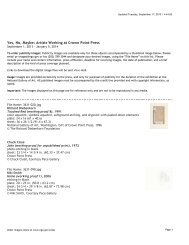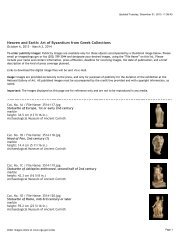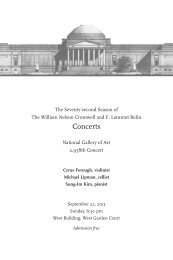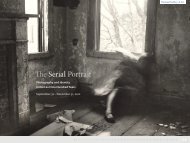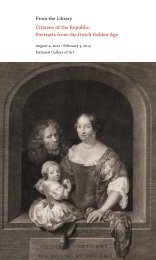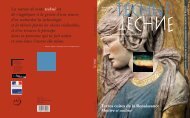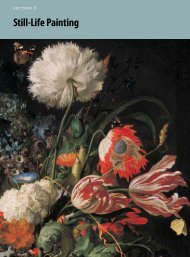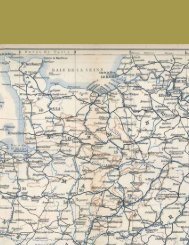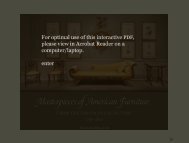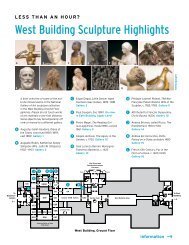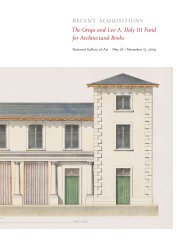Download Report - National Gallery of Art
Download Report - National Gallery of Art
Download Report - National Gallery of Art
Create successful ePaper yourself
Turn your PDF publications into a flip-book with our unique Google optimized e-Paper software.
Object conservators Katy May and Abigail Mack complete a<br />
re-patination treatment <strong>of</strong> Lucas Samaras’ Chair Transformation<br />
Number 20B.<br />
The photograph conservation department continues<br />
its collaboration with the <strong>Gallery</strong>’s scientific research and<br />
photographs departments and colleagues at partner institutions<br />
on a comprehensive investigation <strong>of</strong> the technical<br />
history, chemistry, materials characterization, connoisseurship,<br />
preservation, and conservation <strong>of</strong> platinum and<br />
palladium photographs. Japine: William Willis’ Proprietary<br />
Paper was co-authored with colleagues at the Metropolitan<br />
Museum <strong>of</strong> <strong>Art</strong> and presented at the 2012 annual meeting<br />
<strong>of</strong> the American Institute for Conservation, illuminating a<br />
long-forgotten class <strong>of</strong> platinum prints favored by leading<br />
photographers <strong>of</strong> the early twentieth century. A technical<br />
investigation <strong>of</strong> waxed paper negatives began for the<br />
upcoming exhibition Captain Linnaeus Tripe: Photographer<br />
<strong>of</strong> India and Burma, 1854–1860.<br />
The department completed forty-five major treatments,<br />
168 minor treatments, and 755 examinations for exhibitions,<br />
loans, acquisitions, and donor development. The<br />
majority <strong>of</strong> conservation treatment was in preparation for<br />
the exhibitions I Spy: Photography and the Theater <strong>of</strong> the<br />
Street, 1938–2010; Modern Lab: Material Interventions;<br />
and The Serial Portrait: Photography and Identity in the Last<br />
One Hundred Years. Among the conservation challenges<br />
was Ilse Bing’s Self-Portrait, a complex collage <strong>of</strong> silver<br />
gelatin photographs, electrostatic prints, black paper, metal<br />
wire, mirrors, and a clock in an acrylic box frame.<br />
Object conservators completed seventeen major<br />
treatments, ninety-one minor treatments, and 829<br />
PRESERVING<br />
42<br />
examinations <strong>of</strong> sculpture in preparation for acquisition,<br />
loan, and exhibition. One <strong>of</strong> the many challenging treatments<br />
was the stabilization and support <strong>of</strong> the weakened<br />
original suspension strings <strong>of</strong> Alexander Calder’s<br />
Cascading Flowers. After ten years <strong>of</strong> exhibition in the<br />
Sculpture Garden, Lucas Samaras’ Chair Transformation<br />
Number 20B was completely re-patinated, returning<br />
the sculpture to the appearance intended by the artist.<br />
Surface grime and discolored overpaint were removed and<br />
losses were filled and inpainted on the fifteenth-century<br />
Florentine, polychrome sculpture Saint John the Baptist.<br />
Marc Chagall’s ten-by-seventeen-foot mosaic continued<br />
to engage conservators as each individual panel was treated<br />
after being de-installed from its former Georgetown<br />
garden wall location. Additional treatments in progress<br />
include José de Rivera’s painted aluminum sculpture<br />
Black, Yellow, Red; three miniature wax portraits depicting<br />
scenes from the Passion <strong>of</strong> Christ; Henri Matisse’s<br />
Figure Decorative; and the late fifteenth-century painted<br />
and gilded wood sculpture The Holy Kinship.<br />
Object conservators contributed to the exhibition catalogue<br />
and collaborated on wall texts, public lectures, and a<br />
featured website for Antico: The Golden Age <strong>of</strong> Renaissance<br />
Bronzes. Technical investigation <strong>of</strong> serial bronze casting<br />
in nineteenth-century France, in particular Théodore<br />
Gericault’s Flayed Horse I, II, and III, complemented<br />
research <strong>of</strong> Renaissance bronzes funded by the Smith<br />
Family Foundation.<br />
The loans and exhibitions conservators worked on<br />
seventeen major exhibitions, completing more than 1,682<br />
incoming and outgoing condition reports, and constructed<br />
twenty-six micro-climate and water-pro<strong>of</strong> packages for<br />
outgoing loans. Frame conservators completed more than<br />
220 minor treatments and eleven major treatments.<br />
The exhibition program posed new and interesting<br />
challenges for the conservators. Colorful Realm: Japanese<br />
Bird-and-Flower Paintings by Itō Jakuchū (1716–1800)<br />
required extensive collaboration between the exhibition<br />
conservator and the <strong>Gallery</strong>’s facilities maintenance<br />
engineers to create a custom environment for the delicate<br />
scrolls. Masterpieces <strong>of</strong> American Furniture from the<br />
Kaufman Collection, 1700–1830; Warhol: Headlines; Joan<br />
Miró: The Ladder <strong>of</strong> Escape; and Color, Line, and Light:<br />
French Drawings, Watercolors, and Pastels from Delacroix<br />
to Signac all required lengthy participation at lender<br />
homes and partner venues.<br />
The outgoing loan program continued to challenge conservators<br />
to innovate. To provide a controlled environment<br />
for the delicate recto/verso panel <strong>of</strong> Dürer’s Madonna and<br />
Child, conservators devised a new system for creating a<br />
micro-climate package within the frame.<br />
Frame conservators worked on several special projects<br />
including the re-sizing <strong>of</strong> the Dutch seventeenth-century<br />
ripple-mold frame for Willem van de Velde’s Marine.




